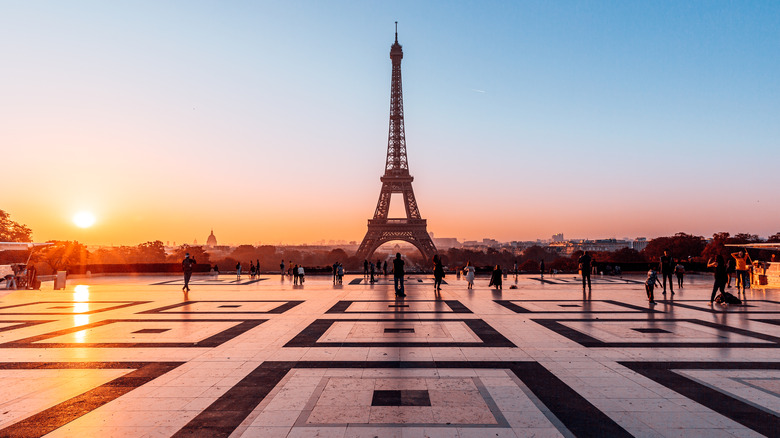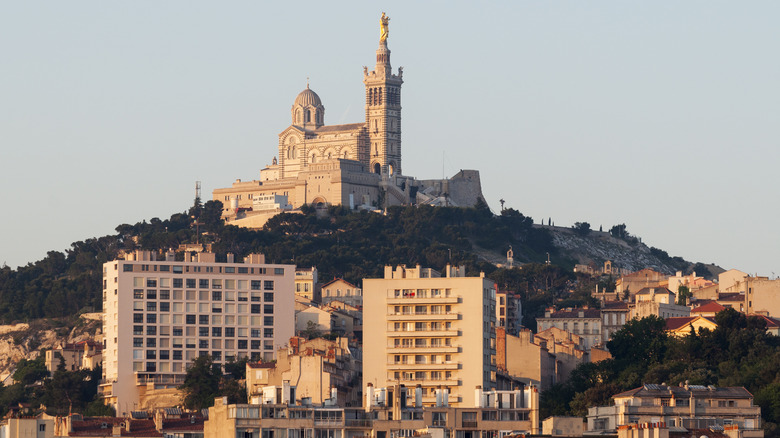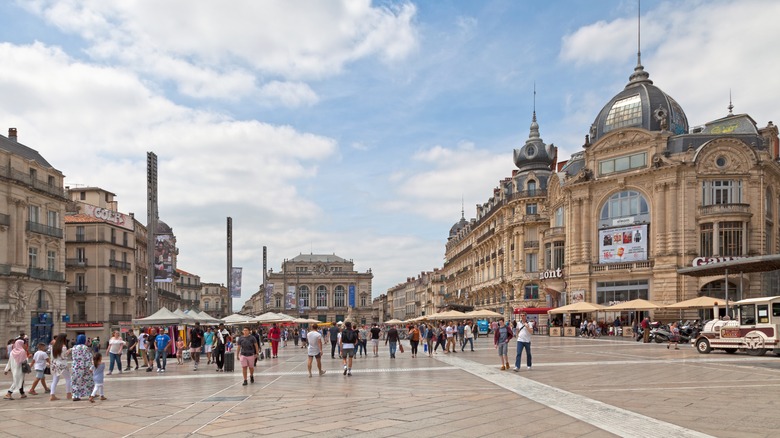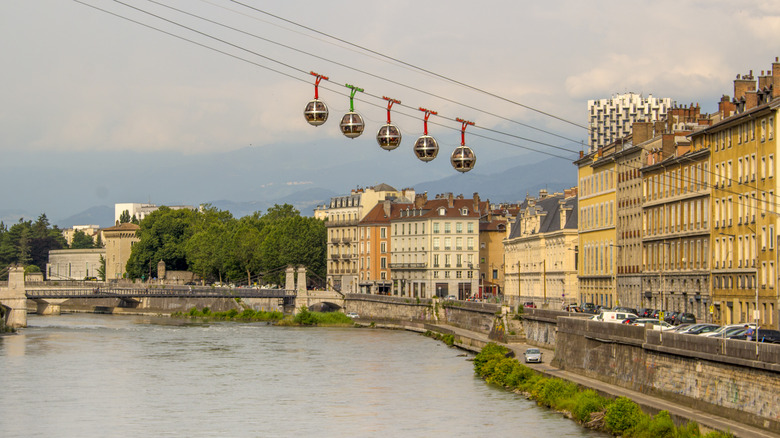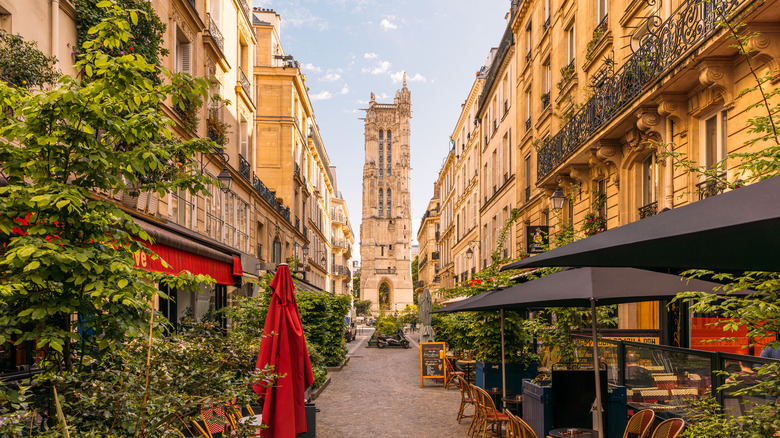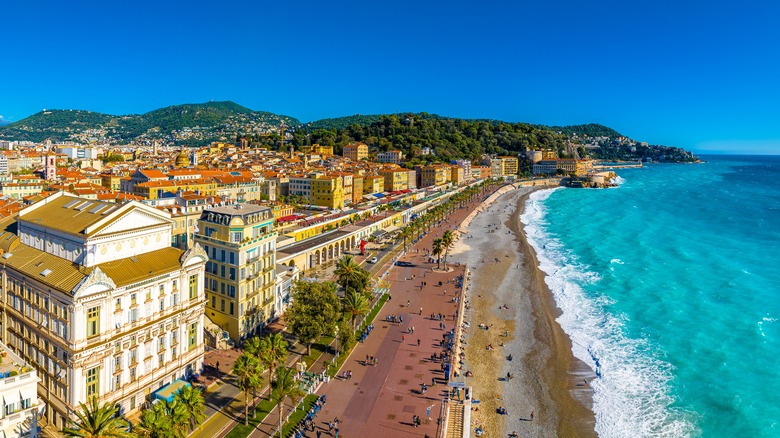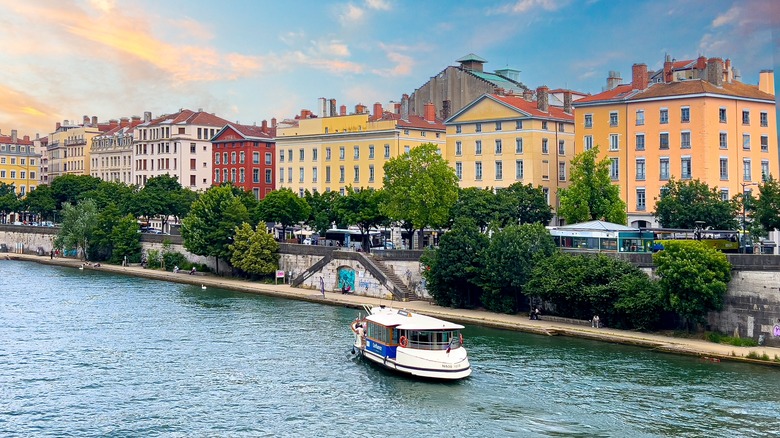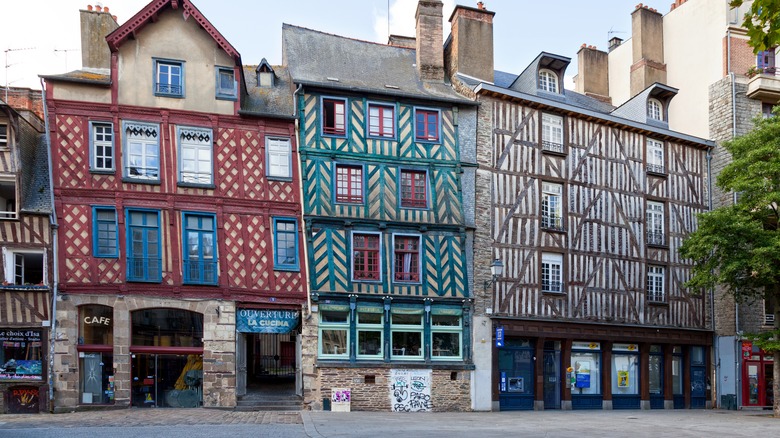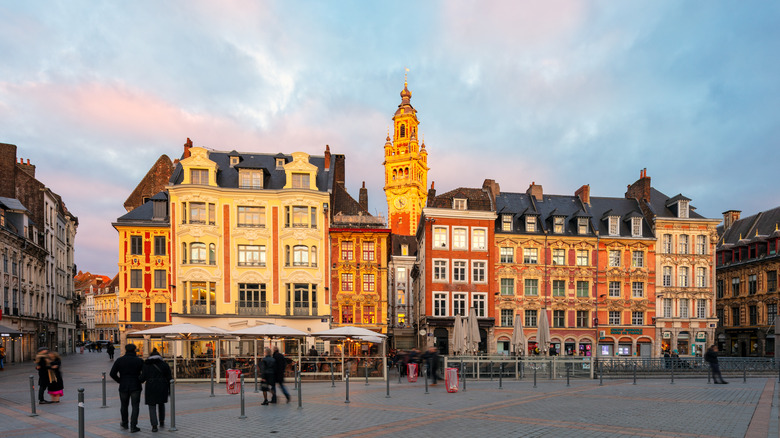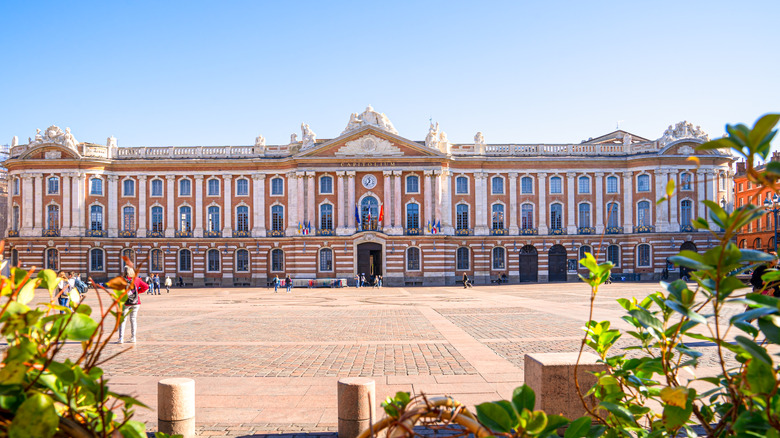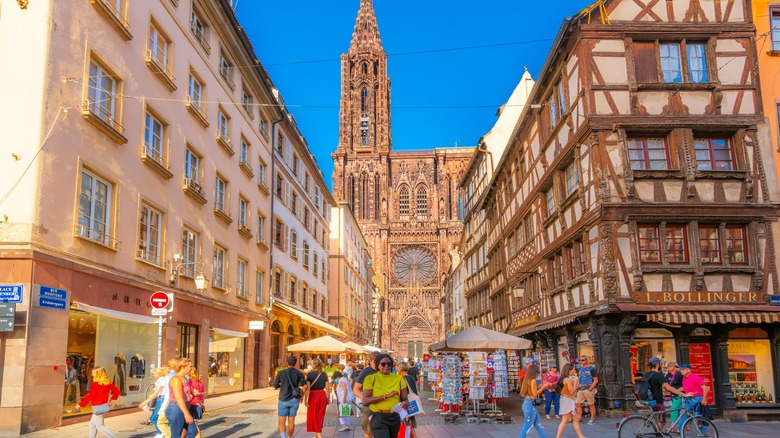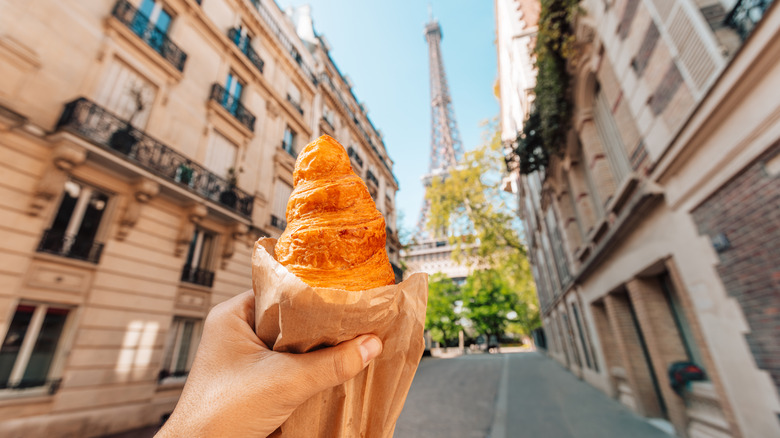The Most Dangerous Vacation Destinations In France, According To Research
Admired for its vineyards, pockets of gastronomic excellence, rich history, and culture, it's little wonder that France is so popular. Indeed, its windswept northern coast fringed with ancient fortifications, mountainous borders, forested heartland, and island-dotted Riviera presents an eclectic array of opportunities for the would-be traveler. In 2023, some one hundred million people journeyed to France, making it the most visited country in Europe and more well-trodden than the UK and Italy combined.
Still, France is not without its problems. In 2023, it received a Global Peace Index score of 1.939, marking it as one of the least safe places in Europe and well ahead of more sedate locations such as Switzerland, Germany, Ireland, and Croatia. The Organised Crime Index marked France as a nexus for human trafficking, cybercrime, and the drug trade; in their most recent survey, they noted a slight uptick in criminal activity, ranking it 9th in Europe and 58th in the whole world. Such lawbreaking is, of course, not uniformly distributed; tourism invites criminality — often of the pettier variety — while in other locales high crime rate stems from socio-economic factors specific to the region.
Context, then, is important, as is the need to keep things in perspective. All countries have to deal with their fair share of crime, and although France has issues, it remains a lot safer than the U.S. It is the unfamiliarity with surroundings coupled with the relaxed posture that comes with travel that makes travelers easy marks.
The cities below are all locations that suffer from relatively high crime rates. Selected by Organized Crime Index score and cross-referenced via surveys conducted by residents, they offer a snapshot of only the worst these municipalities have to offer. Yet, beneath the grime — in all cases — lies a city worthy of exploration.
Marseilles
Marseilles is the third largest city in France, home of the infamous Castle If — the legendary prison linked to the story of the Count of Monte Cristo — and, for those yet to experience it, a must-see attachment to any French itinerary. It's the oldest city in France, founded way back in 600 BC by Greek settlers, and as you might expect from such an ancient, well-populated locale, Marseille presents a blend of the old with the ultra-modern.
Cathedral spires dating from the 15th-century tower over 17th-century hotels and compete at eye-line with that other Marseilles landmark, The Basilica Notre-Dame de la Garde, or la Bonne Mère as it is known to the locals, a 19th-century byzantine-revival masterpiece. Yet contemporary wonders exist too, such as the shaded La Villa Méditerranée and Jean Nouvel office block.
Sightseeing is at a premium here; the city is blessed with a superb harbor, littered with street markets, and blessed with a wealth of coastal walks, world-class café culture, and scintillating nightlife. Alas, even in such an idyllic location, crime proliferates. Visitors describe the crime levels as high, listing car theft and robbery as principal concerns. Problems with violent gangs linked to the drug trade are also on the rise in Marseille, with homicides related to the illicit trade reaching an unprecedented 49 in 2023.
Still, as with many of the places on this list, alarmist headlines need to be taken with a pinch of salt. Over 16.2 million people visited Marseilles in 2023, and despite its Crime Index rating of 66.2, most left blissfully unaware of its dicey reputation and found themselves instead much enamored of one of the most beautiful locations on the Riviera.
Montpellier
Situated in the southern half of France, just 12 km away from the Mediterranean coast, Montpellier is a thriving town famed for its gothic Cathedral, chic neoclassical Antigone district, and stunning 18th-century Promenade du Peyrou. The city sports its very own Arc de Triomphe, is littered with private mansions, and is home to the oldest faculty of medicine in the world, an institute that has been in continuous operation since the 12th century. Each summer, tourists arrive in droves.
Indeed, the entire historical region of Occitania, of which Montpellier is a part, ranks 1st in terms of the number of French tourists and 4th as far as total numbers of foreign visitors are concerned. Accommodation is plentiful and ranges from the high-end luxury boutique hotel to budget-friendly camping. Unfortunately, although the region itself is known for its fine beaches, affordability, and previously low crime rate, Montpellier has, at times, managed to buck that trend. Its Crime Index score of 62.66 means that the level of crime remains high, and to make things worse, the trend has been ticking upwards of late. Reports of urban violence and the recent attempted murder of a young schoolgirl have rocked the community in recent years. Certain areas, such as the train station, are known hotspots for pickpockets and purse-snatchers, while others, such as La Mosson, the city's football stadium, are best avoided entirely when there's a match on.
Still, the historic heart of the city remains a safe and tranquil place. Montpellier, like most cities has its good and bad neighbourhoods. Its reliance on tourism means that law enforcement takes a proactive approach to keeping people safe, and that is especially true of high footfall areas such as the Cathédrale St-Pierre, must-see Arceaux market, and stunning 16th-century botanical gardens.
Grenoble
In 2020, videos of drug dealers openly carrying assault rifles in Grenoble sparked outrage across France. The intensity of the gang war has only escalated since then. It is in line with a noticeable uptick in reported crime, with visitors listing drug dealing, theft, and muggings among their most serious concerns. Grenoble is located directly north of Marseille in the Auvergne-Rhône-Alpes region of south-eastern France. Famed for its winter sports, the 1968 Winter Olympics were held there. It is also home to the Université Grenoble Alpes, a magnificent Bastille Fortress, and distinctive, spherical cable cars known as Les Bulles.
The city is relatively compact, with its old town markets and impressive Archaeological Museum within walking distance of one another. The history here dates back some 2000 years — the city itself was named after the 4th-century Roman emperor Gratian and is far enough south to have been occupied by Arab forces during the 9th and 10th centuries. Napoleon stopped here in 1815 on his march back to Paris when the city was known for its production of fine gloves; today, it is better known for its use of hydropower and as a center of academic research.
The city's history is well-represented in the eclectic architecture present throughout, and visitors can make full use of novel features such as a stay in a 17-th century boarding school repurposed as a luxury hotel or a wander around the 3rd-century crypts of the Baptistery of Grenoble. Wandering around this beautiful city helps put the crime levels into perspective. Tourists always need to keep their wits about them when traveling in unfamiliar climes, and in this, Grenoble is little different from any other city in France.
Paris
Paris is unsurprisingly, the most visited city in France and, as is the case with most capital cities, scores quite highly on the Crime Index. It currently sits at 57.95, making it the sixth most dangerous city in France. To compound matters, the rate of lawbreaking has been increasing of late and stories of crackdowns on criminality prior to the 2024 Olympic games have done little to dispel the notion that Paris is a dangerous city.
Still, the capital is known for so much more than the danger it poses to unwary travelers. A city of fine cuisine and magnificent desserts, the French municipality is the undisputed museum capital of the world, sporting over 297 of them as of 2019. It's also known as the city of romance, a reputation enhanced by its elegant architecture, curated garden walks, and lively street music. For those willing to explore, there is much to recommend. The city's café culture alone makes any visit well worthwhile but the addition of candlelight concerts, cycles along the Seine, as well as a thousand and one other activities makes Paris a legitimate bucket-list item.
Pickpockets and purse snatchers, do, of course, operate around areas of high traffic with the area around the Eiffel Tower being particularly notorious; however, the police presence here is of some comfort. Parisian law enforcement is tasked with ensuring tourists are always kept safe, and as long as the usual precautions are taken when traveling, you are unlikely to encounter criminals of any description.
Nice
Nice has long been something of a tourist magnet. Situated on the French Riviera and famed for its pebble-strewn shore, calm blue waters, and longstanding connection to the art world, it is the second most visited city in France. The climate here is perfect for walks along the Promenade des Anglais — a four-mile stretch of coast named after the English aristocrats who financed its construction — with highs of 79 degrees Fahrenheit in May, which rises to the low 80s come August.
For those more interested in culture than sunshine, the red-roofed houses and cobbled streets of old-town put you in close proximity to the magnificent Nice Opera House, art galleries, and a museum dedicated to one of Nice's most famous residents, Henri Matisse. It's also possible to skip the crowds while still getting to enjoy all the Nice has to offer. Traveling up or down the coast for an hour or so reaps rewards; fine beach towns such as the picturesque Menton or the yacht-friendly Antibes dot the landscape.
Crime is certainly a problem here with vandalism and theft being of chief concern. In 2020, police were given expanded powers to tackle drug trafficking in the coastal city, and videos of gunmen outside a residential block initiated calls for the Federal government to intervene. Still, as concerning as such headlines are, the actual risks to tourists visiting Nice remain vanishingly small. During the high season, Nice's population almost doubles, but police are plentiful, and the city's 4000 cameras are ever-watchful. Crime and safety are linked, but not inextricably so: indeed, Le Parisien described it as one of the safest large cities in France in terms of reported burglaries, assaults, and thefts.
Lyon
As you'd expect from a city with such a reputation for food, café culture and restaurants abound. As of 2024, it sported no fewer than 86 Micheline-starred restaurants — an impressive total for a city of half a million people. Highlights include the vegetarian-friendly M Restaurant with its impressive market-sourced menu, the tradition-focused Le Musée, and the elegant simplicity of the tasting menu at Takao Takano.
Between meals, visitors find themselves treated to trips up and down the Rhône on rented motorboats, dips in an outdoor pool, or a stroll around one of the city's many galleries and museums, such as the fabulous Musée des Confluences. The food market of Saint-Antoine/Célestins is also something of a draw, particularly over the weekend when some 121 stalls operate, selling all manner of fish, poultry, cheese, and pastries.
Still, headlines reporting fatal stabbings in the subway and antisemitic attacks have done much to mar Lyon's reputation of late. Its Crime Index score of 56.09 is in line with visitor perceptions of how safe it is to walk the street at night, but as ever, such metrics require analysis. Lyon is hardly alone when it comes to troubled neighborhoods, but those who stick to the main tourist tracks have little to worry about when it comes to violent crime. Lyon is less crowded than Paris, but watching out for scams and pickpockets is, of course, par for the course.
Rennes
Rennes stands out from many of the cities on this list in that it is less of a resort and more of a working town that just so happens to have a tourist pull of its own. The capital of and largest city in Brittany, Rennes' mix of stunning architecture, fantastic shopping, and museums draws in crowds year-round. Its position to the west of Paris gives some indication as to the climate: spring and fall showers are common, and mild summers are the norm. Still, such proximity makes it ideal for a weekend break, and many Parisians treat it as such.
The city's reputation as a foodie paradise, coupled with its laidback atmosphere, will soon have you dining like a local. At the same time, its many half-timbered medieval buildings bring its historical heritage into sharp focus. Meanwhile, the ever-popular Musée des beaux-arts de Rennes houses a wealth of treasures to discover, including paintings by both Rubens and Georges La Tour.
Rennes is also home to the Marché des Lices, a bustling market that recently celebrated its 400th anniversary. Famed for its hotdogs, seafood, baguettes, cheese, and so much more, it is one of the largest markets in all of France, second only to Rungis in Paris.
Such traffic does, of course, invite crime, and although Rennes' Crime Index score of 53.17 makes it the lowest on this list thus far, visitors have nevertheless expressed some concern. Drug use is of particular concern, and on-the-spot fines for users were piloted in 2019 prior to the program being rolled out nationwide.
Lille
The capital of the Hauts-de-France and situated close to the Belgian border, Lille is a university town more than anything else, but that doesn't prevent crime from rearing its ugly head from time to time. As with Rennes, drug use is an issue, but here in Lilles, visitors have also had to deal with theft of property.
The city is dominated by its central square, the Grand Place, where the Flemish influence is well-represented; here and across the city's ancient heart, quaint 17th-century brick houses and narrow cobbled streets are the norm. There's a lively Sunday market to enjoy, a stunning Louis XVI-style opera house, and countless museums and art galleries such as the Palais des Beaux-Arts and Musée d'Histoire Naturelle de Lille.
Indeed, the city is so alive with culture, cafés, and historical sightseeing opportunities that it is sometimes considered a budget-friendly alternative to Paris. And in terms of criminal activity, it also fares better than the capital. Still, visitors rate the chance of safely walking alone during the night as low, and the general perception that crime has been rising in recent years seems at least somewhat pervasive.
Toulouse
Situated close to the Spanish border and granted the nickname La Ville Rose thanks to its rows of pink-hued terracotta buildings, Toulouse is so crisscrossed with waterways that it has become a veritable city of bridges. Must-see attractions include the imposing Couvent des Jacobins, a gothic masterpiece that began construction during the early 13th century. There's also the Neoclassical splendor of the Place du Capitole overlooking the city's central plaza, the Musée des Augustins (one of the oldest museums in all of France), and, of course, boat trips down the Garonne, the city's principal river.
Reports of warring drug gangs, gun violence, and even a dramatic armed siege rocked Toulouse in recent years as some suggested it might become the new Marseilles and descend into chaos. Thankfully, such an extreme situation does not appear to have developed.
Visitors are generally safe walking about during the daytime, although professional pickpockets certainly operate around tourist hot spots. Walking around at night is, however, another matter with its safety level marked as low. That said, a little common sense does much to mitigate any danger you might face. Most crimes are petty in nature and are carried out in isolated parts of the city far from the more heavily trafficked, densely policed center.
Strasbourg
Strasbourg is the third most visited city in France and the seat of the European Parliament. It sits near the border with Germany, and as is often the case with border towns, it generates a lot of traffic and no small amount of criminality. The blend of French and German culture is very much on display in this city — Strasburg was a German city for much of its history — and this is represented in both its architecture and cuisine. The astronomical clock that sits inside the 11th-century Cathédrale Notre-Dame is a genuine paragon of Renaissance brilliance. Visitors gather to admire its animated figures as they spring to life at 12:30 pm daily.
The city's Christmas market is also world-class. Still, those visiting in summer can spend their time wandering around cute café and gallery-laden districts such as the Krutenau and the Europa amusement park or sign up for any one of dozens of historical walking tours. Once again, tourists need to watch out for pickpockets, purse snatchers, and other petty crimes. These seem to form the bulk of the city's Crime Index, which tends to hover around the moderate to low mark. An armed attack on civilians enjoying the Christmas market in 2018 appears to have been an isolated incident. Although migrant smuggling and organized drug gangs are a definite issue, the city is, for the most part, a safe and beautiful place to visit.
How we assesed
As stated earlier, each location was selected via its crime index score as listed on the database compiled by Numbeo. We scoured news sites for major crime stories, and everything was cross-referenced via the Organized Crime Index personal experience, forums, and travel blogs.
